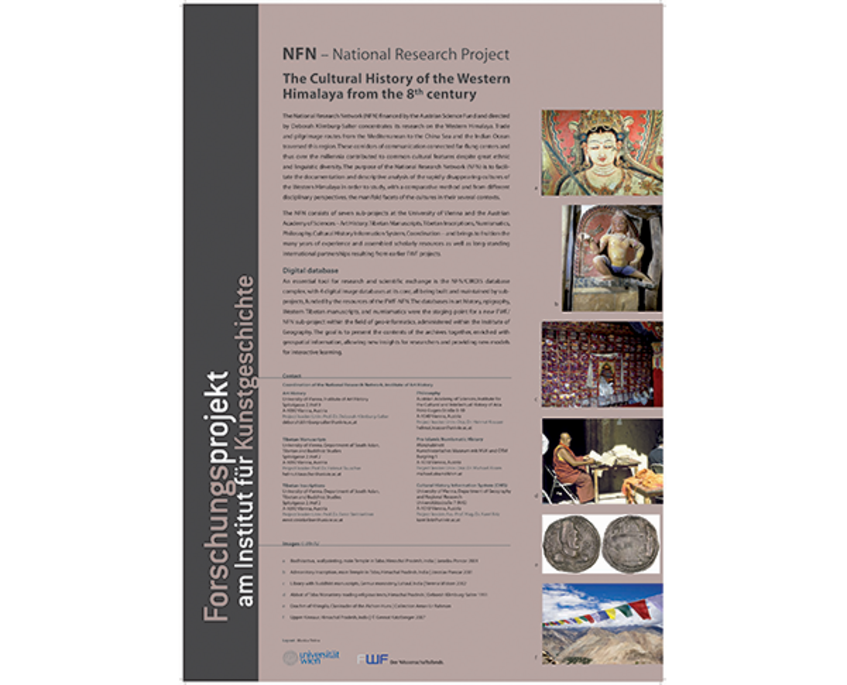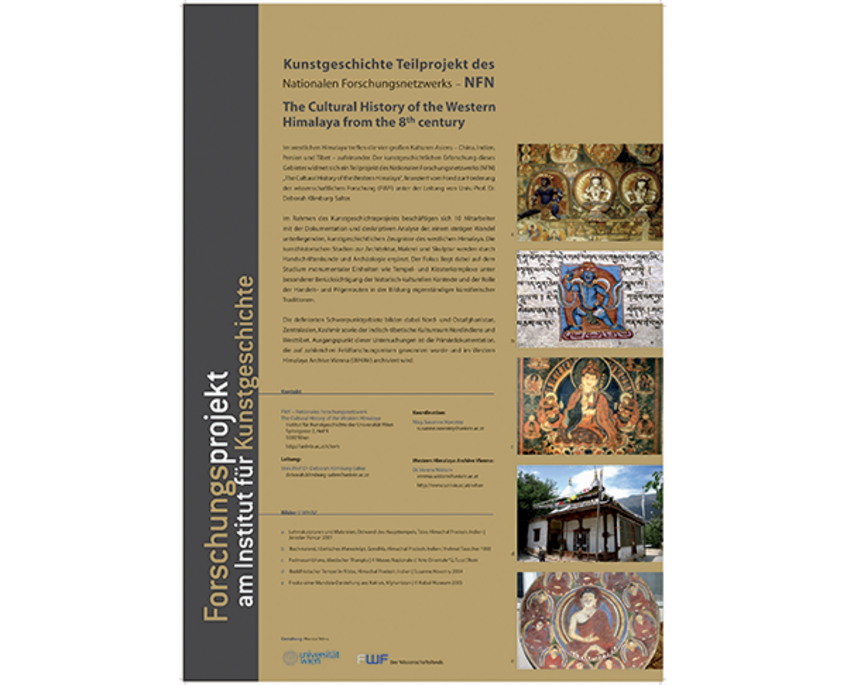FWF-Nationales Forschungsnetzwerk: Kulturgeschichte des westlichen Himalaya seit dem 8. Jahrhundert
The Cultural History of the Western Himalaya from the 8th century.
Coordination sub-project
S 9801 (01.01.2007 - 31.12.2009)
Leitung: Prof. Dr. Deborah Klimburg-Salter
Mitarbeiter:
Dr. Matthew Savage: Coordination
Jürgen Schörflinger: technischer Mitarbeiter
Art History
sub-project
S 9802 (01.01.2007 - 31.12.2009)
Leitung: Prof. Dr. Deborah Klimburg-Salter
MitarbeiterInnen:
Dr. Erika Forte, Mag. Linda Lojda, Mag. Susanne Novotny (Karenz),
Mag. Kerstin Schödl, Dana Seitz, Mag. Dr. Verena Widorn


Western Himalaya Archive Vienna (WHAV) der Universität Wien
Leitung: Mag. Dr. Verena Widorn
MitarbeiterInnen: DI Sean Mc Allister, Petra Müller, DI Uwe Niebuhr, Mag. Kerstin Schödl, Monica Strinu, Verena Ziegler
Weitere Informationen, mehr ...
Abstract
The four great cultures of Asia - China, India, Persia and Tibet - converge in the Western Himalaya. Trade and pilgrimage routes from the Mediterranean to the China Sea and the Indian Ocean traversed this region. These corridors of communication connected far flung centers and thus over the millennia contributed to common cultural features despite great ethnic and linguistic diversity.
The purpose of the National Research Network (NFN) is to facilitate the documentation and descriptive analysis of the rapidly disappearing cultures of the Western Himalaya in order to study, with a comparative method and from different disciplinary perspectives, the manifold facets of the cultures in their several contexts. The NFN "The Cultural History of the Western Himalaya from the 8th Century" continues the successful Forschungsschwerpunkt (FSP) of a similar name (2001-2006). The NFN brings to fruition the many years of experience and assembled scholarly resources as well as long-standing international partnerships resulting from earlier FWF projects.
The NFN is closely associated with the Research Platform (Center for Interdisciplinary Research and Documentation of Inner and South Asia = CIRDIS) at the University of Vienna. As an important innovation of the newly structured University, CIRDIS is seen as a mechanism to provide an institutional basis for research at the highest international standard which also connects to the University's other programs and long-term goals. Through co-financing with the University (CIRDIS) and third-party donations, the NFN augments the existing Austrian research facilities and provides academic support for promising young scholars, thus complementing the standing faculty positions and teaching activities within the University.
The NFN continues research in the areas of major innovation already defined in the FSP.
For example, the definition of an independent western Tibetan canonical tradition; Tibetan literature as preserved (usually in unique forms) in wall texts; the independent Indo-Tibetan artistic tradition for which the historical and cultural contexts can be defined on the basis of the newly discovered evidence from manuscripts colophons, wall and stone inscriptions among other sources.
The new sub-projects of the NFN that have emerged out of the existing research interests of the FSP projects provide an expanded network of scientific collaboration: Numismatics (crucial for the cultural history of pre-Islamic Afghanistan, Pakistan, Kashmir, and Northwest India) and Philosophy with emphasis on the Kashmiri intellectual tradition of the 10th-12th centuries, Tibetan manuscripts research and codicology.
The interconnected databases begun in the FSP are the basis for the Cultural History Information Systems Project. One of the goals is a high quality cartographic output based on a digital/analogue concept which allows the viewer to derive a holistic view of the entire data produced through the different sub-projects of the NFN in a regional, cultural, and historical context.
Forschungsnetzwerk NFN
Forschungsplattform CIRDIS
